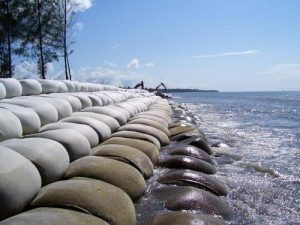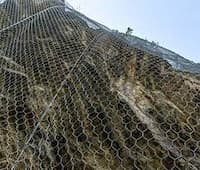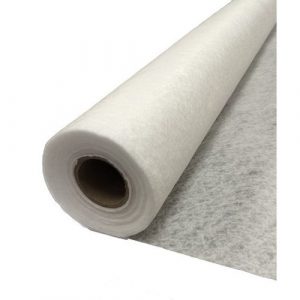How Geotextile bags makes Civil Engineering Easier?

A geotextile bag, also known as a geobag, is a large synthetic fabric bag used for various civil engineering and environmental applications. Geotextile bags are typically filled with soil, sand, or other granular materials and then stacked or arranged to form structures such as retaining walls, breakwaters, or erosion control barriers. They can also be used for shoreline protection, land reclamation, and sediment containment in water bodies. The geotextile material used in the bag provides filtration and erosion control properties while allowing water to pass through.
Using permeable fabric, soil can be filtered, protected, separated, reinforced, sealed, and drained with geotextile bags. Due to their protective layer, which raises UV resistance and protects against damage, these bags are primarily used for civil engineering. There are various names for these bags; they are also called:
- Geo Bag
- Non-Woven/Woven Geo Bag
- Geotextile Sand Container
- Sand Bags
Table of Contents
What is the use of geotextile bags in Civil Engineering?
Below mentioned are some points that explain why geotextile or geo bags are used for civil engineering:
- Erosion control: Geo bags stabilise slopes and prevent erosion by slowing down water flow and retaining soil particles.
- Shoreline protection: Geo bags can protect shorelines from erosion caused by waves and currents. They can be stacked to form breakwaters or placed along the shore to create artificial beaches.
- Retaining walls: With geo bags, you can build retaining walls at a lower cost that is easier to construct than concrete retaining walls.
- Land reclamation: Geo bags can create new land by filling them with dredged sediment and stacking them to form a stable foundation.
- Flood control: Geo bags can be used to build temporary or permanent flood control structures to protect against flooding.
How do Geo bags make Civil Engineering Easier?
Geo bags offer several advantages that make civil engineering easier, including:
- Ease of installation: Geo bags can be easily transported to a construction site and filled with local soil or other materials. They can be stacked and arranged without heavy equipment or skilled labour, which can save time and reduce costs. Moreover, geo bags specification are top-notch that make civil engineering easy.
- Flexibility: Geo bags can be used to create structures of different shapes and sizes, making them a versatile solution for a wide range of civil engineering applications.
- Environmental benefits: Geo bags are made of synthetic materials that are resistant to degradation and can withstand harsh environmental conditions. They also provide filtration and erosion control properties that can help protect the environment and preserve natural habitats.
- Cost-effectiveness: Geo bags are often less expensive than traditional materials such as concrete or steel. They can also be reused or recycled, reducing costs and environmental impact.
Overall, geo bags offer a practical and efficient solution for many civil engineering projects, making them a popular choice among engineers and contractors.
What are geo bags specification?
The geo bags specification may vary depending on the intended application and different geo bags manufacturers in India. However, some common specifications of geo bags include:
- Material: Geo bags are typically made of high-strength, non-woven geotextile fabrics, such as polypropylene or polyester. The fabric should be UV resistant and have good chemical and biological resistance.
- Size: The size of a geo bag can vary, with most bags ranging from 0.5 to 5 metres in width and length, and from 0.5 to 2.5 metres in height. The size will depend on the specific application and the design requirements.
- Capacity: Other geo bags specification include that it can hold a range of granular materials, such as sand, soil, and gravel. The capacity of the bags will depend on their size, thickness, and strength.
- Strength: The strength of a geo bag is measured in terms of its tensile strength, tear resistance, and puncture resistance. The bags should have sufficient strength to withstand the loads and stresses of the intended application.
- Permeability: Geo bags should have good permeability to allow water to pass through while retaining the granular materials. The permeability will depend on the type and thickness of the geotextile fabric.
- Ultraviolet (UV) resistance: The fabric of the geo bag should have good resistance to ultraviolet (UV) radiation, which can cause degradation and reduce the bag’s lifespan.
Overall, the geo bags specification should be selected based on the requirements of the specific application to ensure the bags provide the desired performance and durability.
Avail of high-quality geo bags from prominent geo bags manufacturers in India!
Several prominent geo bags manufacturers in India offer high-quality products for various civil engineering and environmental applications. But if you want a range of geotextile bags in different sizes, strengths, and materials to meet the specific requirements of civil engineering work, then you should get in touch with ocean global right now!
The geo bags developed by Ocean Global are both durable and affordable. As a result of their diversity in functions, they can be used for a wide variety of projects. And professionals at ocean global ensure to provide high-class services to its customers. With more than 21 years of experience, we have become one of the top choices when it comes to choosing professional geo bags manufacturers in India.
With our advanced manufacturing facilities, quality control measures, and innovative product development, we as the geo bags manufacturers in India have established a strong reputation in the industry and continue to drive the growth and adoption of geotextile bags in India.
Frequently Asked Questions (FAQs)
What are some common uses of geo bags in civil engineering?
It is possible to use geo bags in a variety of civil engineering applications, including erosion control, shoreline protection, retaining walls, land reclamation, and flood control.
How do geo bags make civil engineering easier?
The advantages of geo bags include ease of installation, flexibility, environmental benefits, and cost-effectiveness. In addition to being easy to transport and arrange on-site, they can accommodate a variety of materials.
What are the advantages of using geo bags in civil engineering?
Geo bags offer numerous advantages in civil engineering, including versatility, ease of installation, environmental benefits, cost-effectiveness, and ability to withstand harsh conditions. It is also possible to reuse or recycle them, which reduces the environmental impact and costs.
What materials are geo bags made of?
Most geo bags are made of polypropylene or polyester, high-strength, nonwoven fabrics. In addition to UV resistance, the fabric should be chemical and biologically-resistant.
What are some key specifications of geo bags?
In addition to their size, capacity, strength, permeability, and UV resistance, geotextile bags are also specified by their capacity and strength. To achieve the desired performance and durability, bag specifications should be selected according to the specific application.



